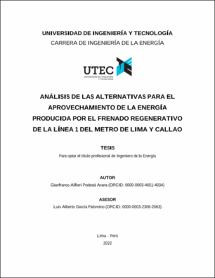Análisis de las alternativas para el aprovechamiento de la energía producida por el frenado regenerativo de la Línea 1 del Metro de Lima y Callao
Fecha
2022Autor(es)
Podestá Arana, Gianfranco Alfieri
Metadatos
Mostrar el registro completo del ítemResumen
Los trenes de la Línea 1 del Metro de Lima y Callao son trenes eléctricos alimentados en Voltaje DC que utilizan el frenado regenerativo para desacelerar, inyectando esta energía eléctrica a la catenaria y que otros trenes la pueda utilizar durante el mismo momento. Sin embargo, se requiere que un tren esté frenando y otro acelerando para que este fenómeno se presente y se aproveche eficazmente, caso contrario, esta energía es desperdiciada siendo disipada en forma de calor sin su posible aprovechamiento. Para aumentar la cantidad de energía reutilizada, en la presente investigación se han descrito las posibles alternativas a implementar como la devolución de energía la red, mediante subestaciones reversibles o sistemas de almacenamiento de energía dentro o fuera del tren, mediante baterías, supercapacitores o ruedas de inercia, con el objetivo de reducir el consumo de la red de alimentación de la Línea 1.
Se utilizó el software especializado en ferrovías eTrax de ETAP para realizar la simulación electrodinámica de la Línea 1 bajo un escenario base y evaluar los efectos bajo escenarios con las alternativas de subestaciones reversibles y bancos de baterías de litio en las estaciones. Los resultados de las simulaciones presentaron ahorros energéticos potenciales en todo el sistema de hasta el 27.98% con subestaciones reversibles y de hasta 3.56% con bancos de baterías instalados en todas las subestaciones de rectificación (SER). Así también, se presentaron reducciones de potencias pico de hasta 977.64 kW en la SER La Cultura, mediante subestaciones reversibles y de 742.51kW en la SER Miguel Grau mediante bancos de Baterías. Estos resultados fueron utilizados para evaluar y seleccionar la alternativa de mejor aplicabilidad en la Línea 1 mediante una matriz MultiCriterio en base a aspectos de Inversión, Performance, Mantenimiento e Implementación, en donde según los criterios de la empresa operaria se presentó la alternativa de subestaciones reversibles como la seleccionada y recomendada para su instalación. The Line 1 of the Lima and Callao Metro Network trains are powered by electric DC voltage and use regenerative braking to decelerate, injecting this electrical energy into the catenary so that other trains can use it at the same time. However, it is required that one train is braking, and another is accelerating for this phenomenon to occur and for this energy be used effectively, otherwise, it is wasted being dissipated in the form of heat without its possible use. In order to increase this amount of reused energy, the present research has described possible alternatives to implement such as the return of energy to the grid through reversible substations, or energy storage systems inside or outside the train, using batteries, supercapacitors or wheels of inertia, to reduce the consumption of the Line 1 power network.
ETAP's eTrax specialized software for railways was used to perform the electrodynamic simulation of Line 1 under a baseline scenario and evaluate the effects under scenarios with the alternatives of reversible substations and lithium battery banks in the stations. The results of the simulations showed potential energy savings throughout the system of up to 27.98% with reversible substations and up to 3.56% with battery banks installed in all rectification substations (SER). Likewise, there were peak power reductions of up to 977.64 kW in the SER Cabitos, through reversible substations and of 742.51kW in the SER Miguel Grau through battery banks. These results were used to evaluate and select the alternative of best applicability in Line 1 through a Multi-Criteria matrix based on aspects of Investment, Performance, Maintenance, and Implementation, where, according to the criteria of the operating company, the alternative of reversible substations was selected and recommended for its installation.


